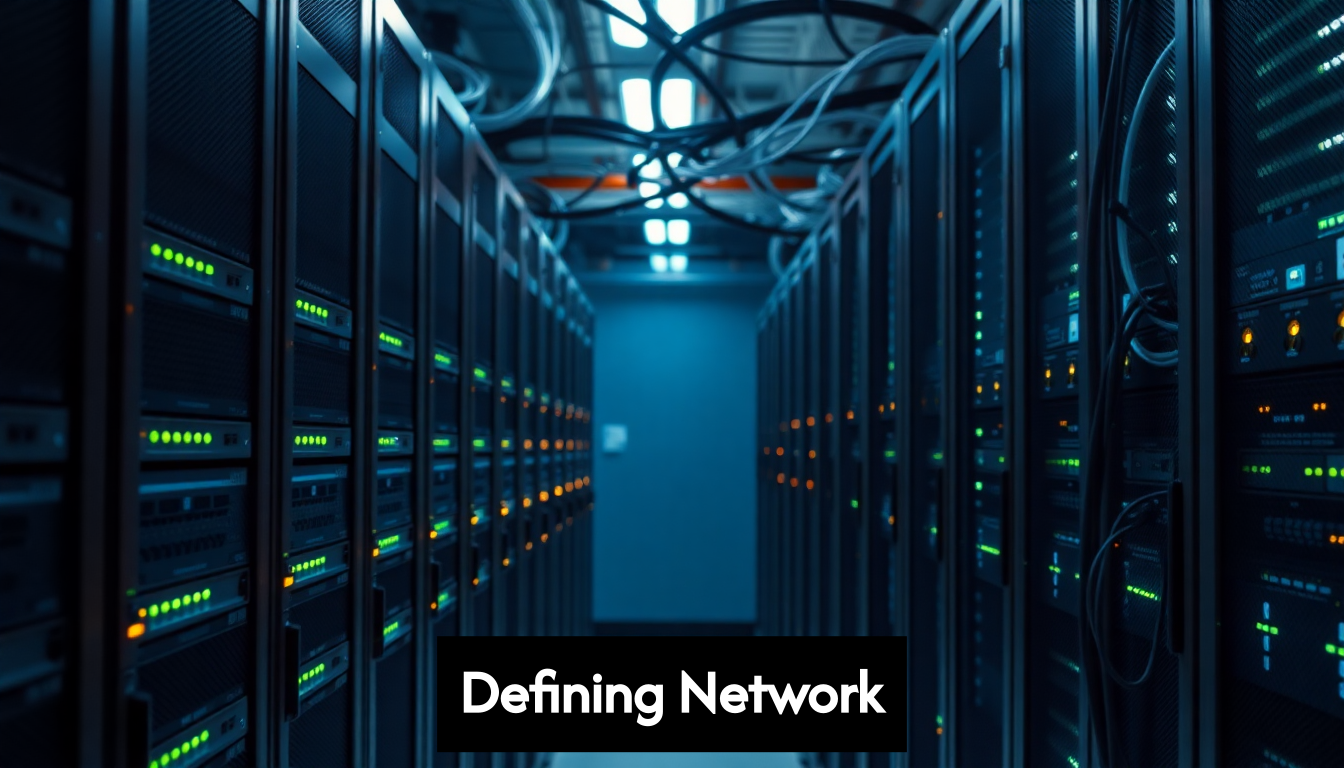
A secure network is essential for protecting valuable data in today’s digital landscape. It’s not just about having firewalls anymore; over 60% of large-scale data breaches in 2024 involved insecure network configurations. But here’s the surprising part: many organisations still underestimate the importance of continuous monitoring and adapting security measures. The real twist? It’s not the expensive technology that makes the difference; it’s the strategic implementation of simple, effective policies that can safeguard your assets and reputation.
Table of Contents
- Defining A Secure Network
- Key Components And Protocols
- Implementing Network Security
- Emerging Trends In Network Security
Quick Summary
| Takeaway | Explanation |
|---|---|
| Prioritise the CIA Triad | Ensure that network security strategies focus on Confidentiality, Integrity, and Availability as these are fundamental principles guiding effective protection measures. |
| Adopt Zero Trust Architecture | Implement Zero Trust principles to continuously verify user identities and limit access to essential permissions, reducing the risk of insider threats and breaches. |
| Deploy Defence-in-Depth Strategies | Use multiple layers of security measures, such as firewalls, intrusion detection systems, and regular audits, to create redundant protections that address potential vulnerabilities. |
| Continuous Security Monitoring is Crucial | Establish ongoing monitoring systems to assess network security status, identify threats, and perform regular vulnerability assessments to adapt against evolving risks. |
| Stay Updated on Emerging Trends | Incorporate new technologies like AI, SASE frameworks, and cloud-native security solutions to enhance network defences and address specific organisational needs effectively. |
Defining a Secure Network

A secure network is the backbone of modern digital infrastructure, providing protected pathways for data transmission while safeguarding against unauthorised access and malicious activities. According to CISA, a secure network “uses a combination of technologies, processes, and policies to protect the confidentiality, integrity, and availability of data as it moves across various network components, including on-premises servers, cloud environments, and connected devices.”
The Three Pillars of Network Security
At its core, network security rests on three fundamental principles that work together to create a robust defensive posture:
- Confidentiality – Ensuring that sensitive information remains private and is accessible only to authorised users
- Integrity – Maintaining the accuracy and reliability of data by preventing unauthorised modifications
- Availability – Guaranteeing that network resources and services remain operational and accessible when needed
These principles form what security professionals often refer to as the CIA triad—the foundation upon which all network security measures are built.
The concept of a secure network has evolved significantly over time. What once focused primarily on perimeter defenses like firewalls has transformed into comprehensive security frameworks. This shift reflects a fundamental misconception in network security thinking. As CIO Magazine points out, “Firewalls and traditional perimeter defenses are no longer sufficient to protect network assets” in today’s distributed computing landscape.
Modern Secure Network Architecture
Today’s secure networks incorporate multiple layers of protection that work together to create a defense-in-depth strategy. This approach acknowledges that no single security measure is impenetrable, so redundant safeguards are essential.
A properly secured network typically includes:
- Robust access controls and authentication systems
- Data encryption for information both in transit and at rest
- Regular security audits and vulnerability assessments
- Intrusion detection and prevention systems
- Network monitoring and traffic analysis tools
For organisations like educational institutions managing student data or manufacturing companies protecting intellectual property, implementing these measures isn’t optional—it’s a business necessity. The rapid digital transformation of recent years has drastically increased network complexity, with Hughes Networks reporting that this change “has dramatically increased the complexity and distributed nature of modern networks, requiring unified, cloud-centric security frameworks.”
Particularly for sectors like logistics and warehousing where operational technology networks intersect with information technology systems, network security becomes crucial for both data protection and physical safety. As Dr. Tina L. Gould, Chief Cybersecurity Architect at the International Cyber Policy Institute, emphasises, “Zero trust is no longer an option for the future—it is a core requirement today. Organizations must assume breach at every layer and design security controls accordingly.”
In essence, a secure network provides the foundation upon which digital operations can function safely and efficiently, protecting both the organisation’s assets and the trust of its stakeholders. As we explore deeper in subsequent sections, we’ll examine how these security principles translate into practical strategies for building and maintaining truly secure networks in various organisational contexts.
Key Components and Protocols
Creating a secure network requires the strategic implementation of various components and protocols working in harmony. Understanding these building blocks is essential for Educational Institutions safeguarding student data, Manufacturing Companies protecting intellectual property, and other organisations maintaining secure operations.
Essential Hardware Components
The physical infrastructure of a secure network includes several critical elements:
- Next-Generation Firewalls (NGFW) – These advanced devices go beyond traditional packet filtering to provide deep packet inspection, application awareness, and integrated intrusion prevention. For shared workspaces and hospitality settings where multiple users access the network, NGFWs help enforce security policies at network boundaries.
- Secure Routers and Switches – The backbone of any network, these devices must be properly configured with security features enabled. Property developers and housing associations should ensure these components include robust access control lists and support for network segmentation.
- Intrusion Detection/Prevention Systems (IDS/IPS) – These systems monitor network traffic for suspicious activities and potential threats, automatically blocking malicious traffic when detected. According to a Hughes Networks report, organisations implementing advanced IDS/IPS systems saw 34% growth in their security posture from 2023 to 2025.
- Network Access Control (NAC) Systems – These verify that all devices connecting to your network meet your security requirements before granting access. For logistics and warehousing businesses with numerous connected devices, NAC solutions are invaluable for maintaining network integrity.
Critical Software Components
Beyond physical hardware, several software components are crucial for network security:
- Virtual Private Networks (VPNs) – These encrypt connections between remote users and your network, creating secure tunnels for data transmission. Educational institutions supporting distance learning rely heavily on VPNs to protect student and faculty connections.
- Security Information and Event Management (SIEM) – These platforms collect and analyse security data from across your network to identify potential threats. As Steven J. Atkins, Director of Security Strategy at Hughes Network Systems, explains, “As organizations extend their networks to the cloud and the edge, unified security frameworks become critical, providing consistent protection regardless of user location or device.”
- Endpoint Protection Platforms – These solutions protect individual devices connecting to your network from malware and other threats. For manufacturing environments where specialised equipment connects to networks, endpoint protection is essential.
Essential Security Protocols
Secure networks rely on several key protocols to protect data in transit:
- Transport Layer Security (TLS)/Secure Sockets Layer (SSL) – These protocols encrypt communications between clients and servers, protecting sensitive information from interception. The hospitality industry must implement these protocols to safeguard guest payment information and personal data.
- Secure Shell (SSH) – This protocol provides secure administrative access to network devices and servers. Property developers managing smart building systems should enforce SSH for all management connections.
- Internet Protocol Security (IPsec) – This suite of protocols secures IP communications by authenticating and encrypting each packet. It’s particularly important for logistics companies connecting multiple warehouse locations.
Zero Trust Architecture Components
Modern secure networks increasingly adopt Zero Trust principles, which operate on the assumption that threats exist both outside and inside the network. The approach, as CISA highlights, requires:
- Identity and Access Management (IAM) – These systems verify user identities and manage their access rights based on least-privilege principles.
- Multi-Factor Authentication (MFA) – This security layer requires multiple forms of verification before granting access, significantly reducing the risk of credential-based attacks.
- Micro-segmentation – This practice divides the network into isolated zones to limit lateral movement should a breach occur. For educational institutions with diverse departments and access requirements, micro-segmentation helps contain potential security incidents.
Implementing these components in a cohesive, layered approach creates a robust security architecture that defends against modern threats while enabling essential business operations. In the next section, we’ll explore how to implement these technologies in practical scenarios to achieve optimal network security for your specific organisational needs.
Implementing Network Security
Successful network security implementation requires a methodical approach that addresses the specific needs of your organisation while following industry best practices. For educational institutions, manufacturing companies, and other target sectors, properly implementing network security is not merely a technical exercise but a strategic business initiative.
Creating a Security-First Network Architecture
A robust implementation begins with designing your network architecture with security as a foundational element rather than an afterthought. This security-by-design approach is particularly critical for property developers and housing associations implementing smart building technologies.
Start by mapping your network’s topology and identifying critical assets. For manufacturing companies, this might include production control systems and intellectual property repositories. For educational institutions, student information systems and research databases require special protection.
Next, implement network segmentation to isolate different parts of your infrastructure. According to CISA, “segmenting enterprise networks and enforcing least-privilege access help protect sensitive systems, such as industrial controls and IoT devices, from targeted cyberattacks and insider threats.” This approach is particularly valuable for logistics and warehousing businesses with numerous connected devices and operational technology systems.
Establishing Security Policies and Procedures
Even the most sophisticated technical controls are ineffective without clear policies governing their use. Your implementation should include comprehensive documentation covering:
- Acceptable use policies
- Access control procedures
- Incident response plans
- Data classification guidelines
- Change management processes
For shared workspaces and hospitality environments, these policies must balance security requirements with the need for convenient guest access. Consider implementing separate networks for guests and administrative functions, with appropriate security measures for each.
Deploying Defense-in-Depth Strategies
Successful network security implementations rely on layered defenses that provide redundant protection. As Faddom notes, “Defense in depth remains a foundational approach in 2025, employing multiple, independent security layers from perimeter firewalls to endpoint detection and continuous monitoring to account for the potential failure of any single layer.”
Begin at your network perimeter by implementing properly configured next-generation firewalls. Then move inward, securing individual network segments, servers, applications, and finally endpoint devices. Each layer should operate independently while contributing to your overall security posture.
For educational institutions with diverse user populations and varying access requirements, this layered approach helps balance accessibility with security. Manufacturing companies can use defense-in-depth to protect both IT and OT networks without compromising operational efficiency.
Implementing Zero Trust Architecture
Contemporary network security implementations increasingly incorporate Zero Trust principles—never trust, always verify—which are particularly relevant for organisations with hybrid work environments and cloud resources.
Priya Banerjee, Senior Security Analyst at Cybersecurity Insiders, emphasises that “Continuous monitoring—and not just perimeter defense—will determine who successfully blocks advanced threats in 2025. It’s about visibility, analytics, and rapid, coordinated response.”
Zero Trust implementation requires:
- Strong identity verification for all users and devices
- Limiting access rights to the minimum necessary (least privilege)
- Continuous monitoring and validation
- Micro-segmentation of network resources
For hospitality businesses and property developers managing multiple locations and diverse user populations, Zero Trust provides a flexible yet secure framework for network access.
Continuous Security Monitoring and Management
Implementing network security is not a one-time project but an ongoing process requiring constant vigilance. Establish continuous monitoring systems that provide visibility into network traffic, user activities, and potential threats.
ACIA survey found that “over 60% of large-scale data breaches in 2024 involved insecure network configurations or inadequate segmentation,” highlighting the importance of regular security assessments and configuration management.
For logistics and warehousing businesses with complex supply chain operations, automated security monitoring helps identify unusual patterns that might indicate compromise. Educational institutions can use behavioural analytics to detect potential data exfiltration or unauthorised access to sensitive research.
Implement a regular schedule for:
- Vulnerability scanning and penetration testing
- Security configuration reviews
- Patch management and updates
- Security awareness training
- Incident response drills
These ongoing activities ensure your network security implementation remains effective against evolving threats while supporting your organisation’s operational needs.
By following these implementation guidelines and adapting them to your specific organisational context, you can create a secure network environment that protects critical assets while enabling productivity and innovation. The next section will explore how to measure and maintain the effectiveness of your network security program over time.
Emerging Trends in Network Security

The landscape of network security continues to evolve rapidly in response to changing threat vectors, technological innovations, and shifting business requirements. For educational institutions, manufacturing companies, logistics businesses, and other organisations, staying abreast of these developments is crucial for maintaining robust network defenses.
The Rise of Secure Access Service Edge (SASE)
One of the most significant trends reshaping network security is the adoption of Secure Access Service Edge (SASE) frameworks. This cloud-based architecture combines network security functions with WAN capabilities to support the dynamic, secure access needs of modern organisations.
According to a recent report by Hughes Networks, “Adoption of Secure Access Service Edge (SASE) frameworks grew by 34% from 2023 to 2025 among major enterprises, driven by demand for unified security across remote and hybrid workforces.”
For educational institutions managing distributed campuses and remote learning environments, SASE offers a way to provide consistent security regardless of location. Similarly, manufacturing companies with multiple facilities can use SASE to create a unified security approach across their operations.
Artificial Intelligence and Machine Learning in Network Defense
AI and machine learning are transforming network security from reactive to predictive by enabling systems to identify potential threats before they cause damage. These technologies excel at spotting anomalies and patterns that might escape human analysts.
Modern AI-powered security tools can:
- Analyse network traffic patterns to identify unusual behaviour
- Automatically respond to threats by isolating affected systems
- Continuously learn from new attack vectors to improve detection
- Reduce false positives that plague traditional security solutions
For logistics and warehousing businesses with complex operational technology networks, AI-driven security tools help protect critical infrastructure while minimising disruptions. Hospitality businesses can leverage these technologies to secure guest networks without compromising the customer experience.
Zero Trust Network Access (ZTNA) Evolution
The concept of Zero Trust has evolved from a theoretical model to a practical approach implemented by forward-thinking organisations. Rather than assuming devices within the corporate network are trustworthy, Zero Trust Network Access requires continuous verification of every user and device.
ZTNA is particularly valuable for property developers and housing associations managing smart building systems with numerous connected devices. By enforcing strict access controls based on identity and context, these organisations can prevent unauthorised access to critical building management systems.
As expressed by Dr. Tina L. Gould, Chief Cybersecurity Architect at the International Cyber Policy Institute, “Zero trust is no longer an option for the future—it is a core requirement today. Organizations must assume breach at every layer and design security controls accordingly.”
IoT Security Specialisation
The proliferation of Internet of Things (IoT) devices has created new security challenges that require specialised approaches. Traditional network security tools often struggle with the unique requirements of IoT ecosystems.
CISA reports that “The Internet of Things (IoT) and Industrial Control Systems (ICS) are now primary targets for attackers,” making specialised security measures essential for organisations deploying these technologies.
For manufacturing companies and logistics operations with industrial IoT implementations, emerging security solutions include:
- Purpose-built IoT security gateways
- Device authentication and certificate management
- Network micro-segmentation for IoT environments
- Continuous monitoring of device behaviour
Cloud-Native Security Integration
As organisations increasingly migrate workloads to cloud environments, network security is evolving to address the unique challenges of protecting cloud-native applications and infrastructure. This trend is particularly relevant for educational institutions and shared workspaces leveraging cloud services for flexibility and scalability.
Cloud-native security integration involves:
- Security tools designed specifically for containerised applications
- API-driven security controls that integrate with CI/CD pipelines
- Cloud security posture management (CSPM) solutions
- Identity-centric access controls for cloud resources
According to CIO Magazine, “Global spending on network security solutions is projected to exceed $192 billion USD by the end of 2025,” with cloud-native security representing a significant portion of this investment.
Quantum-Resistant Cryptography
Looking further ahead, the development of quantum computing poses potential risks to current encryption standards. Forward-thinking organisations are beginning to investigate quantum-resistant cryptographic algorithms to protect sensitive data against future threats.
For educational institutions with long-term research data and manufacturing companies protecting valuable intellectual property, preparing for post-quantum cryptography is becoming an important consideration in network security planning.
By embracing these emerging trends and adapting them to their specific security requirements, organisations across various sectors can strengthen their network defenses against evolving threats while supporting innovation and operational efficiency.
Frequently Asked Questions
What is a secure network?
A secure network is a system designed to protect sensitive data from unauthorised access and threats. It employs various technologies, processes, and policies to ensure the confidentiality, integrity, and availability of data across its components.
What are the key components of network security?
Key components of network security include hardware such as next-generation firewalls and secure routers, software like VPNs and SIEM systems, and essential security protocols like TLS and IPsec. These elements work together to create a comprehensive security architecture.
What is Zero Trust Architecture and why is it important?
Zero Trust Architecture is a security model that assumes threats exist both inside and outside the network. It requires continuous verification of user identities and limits access rights to the minimum necessary, making it crucial for protecting against insider threats and advanced attacks.
How can organisations implement effective network security?
Organisations can implement effective network security by creating a security-first network architecture, establishing clear security policies, deploying defence-in-depth strategies, applying Zero Trust principles, and maintaining continuous security monitoring to adapt to evolving threats.
Elevate Your Network Security with Re-Solution’s Expertise
In today’s volatile digital landscape, the need for robust, secure networks has never been more pressing. As highlighted in the article, over 60% of data breaches stem from insecure network configurations, underscoring the dire consequences of inadequate security practices. With Zero Trust Architecture and continuous security monitoring outlined as crucial strategies, the challenge is clear: keeping your data safe while ensuring seamless connectivity.
!
At Re-Solution, we specialise in tailored IT solutions designed precisely to address these challenges. Our Managed IT Services and Network as a Service (NaaS) offerings ensure that your security posture evolves alongside emerging threats. With over 35 years of experience, we empower sectors from education to manufacturing and beyond to build resilient, secure network infrastructures that protect sensitive information while supporting operational efficiency. Why wait to fortify your network? Visit us at https://re-solution.co.uk and discover how we can partner with you to implement the critical security measures discussed in the article. Secure your future today!
